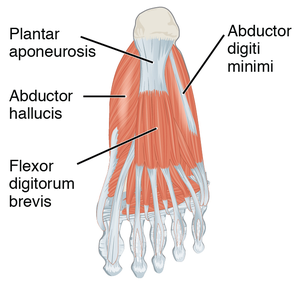Abductor Hallucis
Original Editor - Oyemi Sillo
Top Contributors - Oyemi Sillo
Description[edit | edit source]
Abductor Hallucis belongs to the superficial layer of the plantar foot muscles, alongside the Flexor Digitorum Brevis and Abductor Digiti Minimi.[1] It contributes to the soft tissue prominence on the medial side of the sole.[2]
Origin[edit | edit source]
The Abductor Hallucis muscle originates from the medial process of calcaneal tuberosity, flexor retinaculum, and plantar aponeurosis.[2]
Insertion[edit | edit source]
It inserts on the medial aspect of the base of the proximal phalanx of large toe.[2]
Nerve[edit | edit source]
The Abductor Hallucis is supplied by the medial plantar nerve (S1 & S2), a terminal branch of the tibial nerve.[3]
Artery[edit | edit source]
The Abductor Hallucis is supplied by the medial plantar artery and the first plantar metatarsal artery.[3]
Function[edit | edit source]
Abductor Hallucis flexes and abducts the large toe at the metatarsophalangeal joint.[1]
Clinical relevance[edit | edit source]
As an intrinsic muscle of the foot, the Abductor Hallucis plays an important role in stabilising the medial longitudinal arch of the foot.[2]
References[edit | edit source]
- ↑ 1.0 1.1 Jenkins DB. Hollinshead's Functional Anatomy of the Limbs and Back, 9th edition. Elsevier Health Services, 2008.
- ↑ 2.0 2.1 2.2 2.3 Standring S, ed. Gray's Anatomy: The Anatomical Basis of Clinical Practice, 40th ed. Edinburgh: Churchill-Livingstone, Elsevier, 2008
- ↑ 3.0 3.1 Moore KL, Dalley AF, Agur AMR. Clinically Oriented Anatomy. Philadelphia: Lippincott Williams & Wilkins, 2013







